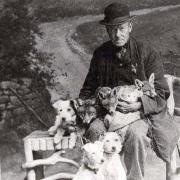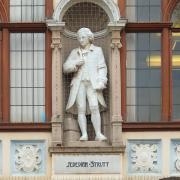When he was appointed chair of the Peak District National Park Authority last July, Narendra Bajaria became the first member of an ethnic minority to head a national park.
When he was appointed chair of the Peak District National Park Authority last July, Narendra Bajaria became the first member of an ethnic minority to head a national park. He feels 'honoured and privileged' to have been offered such an important role, especially one that is so challenging. By his own admission, he is a man who thrives on challenges.
The youngest of eleven children, Narendra was born of Indian parents and brought up in Zanzibar. After studying for a degree in architecture in Mumbai, he came to Britain in 1964 to undertake post-graduate studies in town planning at Leeds University, which he combined with a work placement with Sheffield City Council. Recalling the challenge of gaining acceptance in this country, he said: 'When you take up residence in a new place, you need to have something in common with the indigenous people. For me, the common language was sport; I played badminton at university and joined Millhouses Cricket Club in Sheffield.'
On completion of his studies, Narendra took up permanent employment with the council, eventually becoming Sheffield's chief planner. When the demise of the steel industry created mass unemployment in the city and reduced great swathes of its east end to a wasteland, he was asked to head up the Lower Don Valley Regeneration Team, which had a remit to reverse the fortunes of the old industrial heartlands. The challenge was a daunting one, but Narendra pursued his objectives with skill and enthusiasm. As a result, his team managed to obtain �1.5 billion of investment, create 20,000 new jobs and diversify the city's economic and industrial base.
No sooner had he completed this task than he was asked to head a team charged with reviving Sheffield's city centre, whose decline had been triggered by the building of the huge Meadowhall shopping centre on the northern outskirts of the city. Once again, Narendra proved to be an expert fund-raiser and a man of vision. Thanks to �140 million of investment, he was able to put into action a master plan that included the building of one of the largest urban glasshouses in Europe and the remodelling of the Peace Gardens in the city centre as an inviting walk-through space with dancing fountains and relaxation areas.
Explaining part of the strategy that has helped to revive confidence among the traders, Narendra said: 'On a summer's day, the centre is now like a beach, which is full of children who love to come and enjoy the fountains. When children come to the centre of the city, their parents come too and spend their money there.'
When he stepped down from his job with the council seven years ago, Narendra was delighted to be asked to chair a working party that was given the task of planning the 50th anniversary celebrations of the Peak District National Park, because he has never lost sight of the fact that one third of Sheffield lies within the boundaries of the national park. He was also appointed a member of the National Park Authority and became chair of its planning committee in 2003.
In this new planning role, he was immediately faced with yet another daunting challenge. Ever since 1999, eco-warriors had been occupying tree-houses on Stanton Moor in a protest against the proposed re-opening of the dormant Lees Cross and Endcliffe quarries, which are situated close to an important stone circle. Determined to protect the historic landscape, Narendra supported a package that allowed the quarry operators to extract additional stone from an existing quarry on a less environmentally sensitive site in return for an incremental landscape restoration scheme and an agreement not to work Lees Cross and Endcliffe quarries.
Having demonstrated his ability in helping negotiate solutions that would protect outstanding landscapes, Narendra was an ideal candidate to chair the national park authority.
He says, 'There are no fewer than 70 sites in the park with long-standing quarrying permissions, and 23 of these are active. Most operators are very responsible and work with us, but some prove extremely problematic.'
Quarries are not the only large-scale intrusions in the park. Wind turbines, mobile phone masts and electricity pylons all have a negative impact on the landscape because, being tall, they act as yardsticks and thereby reduce the apparent vertical scale of the Peak's hills and gorges. Conscious of the negative impact on the landscape of tall turbines but aware of the positive benefits of wind power, the national park authority has granted permission for some individual turbines, but has objected to 'wind-farm' clusters. With regard to phone masts and electricity pylons, Narendra would like to see a legal obligation for phone companies to share masts and he is keen to urge the utility companies to put all new cabling underground.
Yet another intrusion has become very evident since the county's traffic engineers began installing a whole raft of new traffic signs on the Peak's trans-Pennine routes. The purpose of their yellow-backed chevrons and gargantuan direction boards is to increase safety on these tortuous roads, but the visual intrusion caused by the new signs is very marked. Narendra is responding to this problem in typical fashion by opening a dialogue with the engineers in order to review existing signs and, if possible, to find ways of reducing signage clutter.
The sheer volume of traffic on these and other roads in the Peak is another of Narendra's pressing worries. Keen to find sustainable solutions to traffic problems, he believes that the building of new roads and by-passes should be seen only as a last resort, because he knows that they would encourage yet more heavy goods vehicles to cross the park. He is also backing a call by the National Trust for national parks to be used as test-beds for 'green travel' schemes for tourists. He says, 'If electrical transport can be provided for visitors to the Canadian Rockies, why can't it be done here?'
More than 10 million visitors come to the Peak Park each year, making it one of the most visited national parks in Europe. Despite his concerns about traffic, Narendra does not wish to reduce this number. In fact, he would like to see it increased, because he is very disturbed by the surprising result of a recent survey which shows that 25 per cent of the population have never visited a national park. Knowing that many of these people live in economically deprived areas, he says, 'We must reach out to the people who have never experienced our national breathing spaces, which should be for everyone's benefit.'
Although Narendra knows that lack of transport and limited money for leisure pursuits are key factors in preventing this group of people from taking advantage of the national parks, he believes that the strategy he used so successfully in Sheffield's city centre could be used to good effect. He says, 'We are working closely with schools to enable inner-city children to experience the national park, and we hope they will act as a catalyst to bring their parents into the Peak District.' Aware that many inner city people are members of black and ethnic minority communities, Narendra is keen to support the Mosaic Partnership, which aims to improve the engagement between these communities and the parks. Of course, his own appointment will make him a valuable role model in this respect.
Other key issues for Narendra's term of office include climate-change, flood-mitigation and habitat improvements, and they all come together in the �4.7m Moors for the Future project, based at the new Moorland Centre in Edale. Narendra sees the Moorland Centre as a demonstration of best practice, with its sedum-turf roof that changes colour with the seasons, bisected by a waterfall that echoes its moorland setting. Powered by a ground-source heat pump, it is a modern, energy-efficient building that blends with the traditional landscape of the national park. From here restoration and research is being carried out on the fragile, eroded peatlands which store more carbon in the UK than all the forests of Britain and France combined.
'Moorlands such as Bleaklow and Black Hill have suffered centuries of damage by wildfires, air pollution, over-grazing and drainage,' explained Narendra. 'Moors for the Future is working to revegetate the bare peat, block gullies to prevent rainfall running straight down into the valleys, and improve these rare habitats for wildlife.' The Prince of Wales visited the centre to hear about this work for himself in the summer.
Like all other British national parks, the Peak District is not simply a preserve for visitors. 38,000 people live in the park and many of those who work within its boundaries have helped to fashion the countryside that is so precious to the nation. Unfortunately, these people find it difficult to buy homes in their own locality because there is such a huge demand for housing from the many retirees and commuters who have an understandable desire to live in a beautiful area. As Narendra says, 'Demand for housing isn't a problem, but we have to address the need for housing. In the last ten years, 400 affordable homes have been created specifically for local people, but much more needs to be done.'
Narendra's own home is just outside the park, on the western fringes of Sheffield, a place that has seen a remarkable regeneration in recent years, thanks in no small measure to the way he met the challenges which he faced as the city's chief planner. In his new role as chair of the Peak National Park Authority, Narendra has taken on the challenge of preserving and enhancing a national asset and making it accessible for everyone. We should all be grateful that he is a man who thrives on challenges.


























